User:FLEM/Week 07
Caretakers Proposal
14 June (Tango Thermique) we start at 9:30 --- afternoon release
IDEAS DUMP
1.Field recording is the term used for an audio recording produced outside a recording studio, and the term applies to recordings of both natural and human-produced sounds.
write themselves in slots throught the whole day and record whatever is happening while they're doing
a day of field RECORDING
2.we never invited other people/voices to speak
Femke " feel the urgency of publishing" why would people hear?
on newspaper: stories valid to hear story on one question what story is important to you?
not the single impression, but the overall collection of the different pieces where everyone gives their own point of view
3.tango session in the morning--> research about caterina mora and translation
LISTENING METHODOLOGY ----> add perfomance side for the listening (e.g. all lying on the floor to listen, or dance)
4. read two things diffractevely: invite people after talking about it in class find a way to present it by everyone--> ask everyone to find a way to record the result of this reading session
5.tape recording/recorder/ cassettes--> a physical object with the recording inside fifthteen pieces inside
--> PUBLISHING METHODOLOGY
6. random ideas
sound poetry
auditive theatre play
different versions/interpretation of the same thing
music composing
different roles
create exchange perform
guinness world record sounds
podcast: talk with cis hetero white men
go back to format of album/chapters/episodes
sound alphabet: when you listen you don't understand, and then you would have a translation to sound
7. translation/transcription/interpretation from something physical to a sound
THE CHOSEN ONE
8. make a folder, were we put different materials in: visual things, a drawing, an image, a fragment of text, and we hand everyone the same materials and see what happens --> multiperpectivism
open folders with a name and added folders inside (jian/erica's last piece)
which contain?
whatever you record must be a field recording [not talking in purpose, just if it resonates with the material] translation from the visual sense to the hearing sense nesting structure
do we want to people to react to each other?
people can add things not audio, like images and texts excerpts, or what they see during the week create different audio pieces where they think it fits inside the folders
do we structure the folders?
implicancies --> how things influence each other insturment podcast: when the guest says a word the podcast is finished--> action/reaction, different audio pieces that one has an impact on the other
until the next meeting: start contributing folders
we have recordings: we listen to them and put them together in one
what does this trigger? like an annotation, you put something and
look at the things that are in the folder and "read" them in a diffracted way and add your own reaction to it
folder branched, we ask contributers to choose 5 folders, do the paths and you arrive at some point were you say i want to work with this, and you try to work with that material and create a piece out of it and you could add that in a different folders.
field recording
sometimes it feels random, but if we say let them resonate with each other and yourself, and use it as a method to choose the place/or time or whatever comes to your mind -->interface to click on them separately
look folder, get inspired, go out, record --> one field recording per day so that then the people could react real implicancies deadlines everyday --> write down date/time on the file so that we know where the implicancies will come
would be better to slit up people in singular individual work --> it's still collective work because they work with each other and talk to each other
other material: don't drop everything it comes, use an annotation and communication and interaction with everything else already in there, create connections, interaction,
How to name files?
You can also share and invite people and upload on the soupboat -->
no hierarchy but horizontal branching ---> what is diffracting content? "Rather than employing a hierarchical methodology that would put different texts, theories, and strands of thought against one another, diffractively engaging with texts and intellectual traditions means that they are dialogically read “through one another” to engender creative, and unexpected outcomes" = content is not hierarchical, everything engage with each other to create something new and start new thoughts and ideas
Proposal draft
The topic of SI18-07 is:
🗂️🗂️🗂️[TOPIC]🗂️🗂️🗂️ Deadlines: Dumping images/texts/videos: [deadline] Recordings: [deadline] Release: 14th of June
Contributors: Mitsa Em Chae Kamo Erica Alex Carmen Kimberley Supi
Caretakers: Emma, Jian, Miriam
This week we decided to split up the groups formed and ask you to make field recordings on your own! it's still collective work because you will be actively working with each other and talk to each other, but through your content instead of your voice.
The concept: A folder in a folder in a folder in a folder!
We prepared some folders on the soupboat for you containing images, text excerpts and video snippets. We ask you to do field recordings inspired by the content of these folders as well as adding images, text excerpts and video snippets to the folder yourself. blabla we react to each other the final interface will be the folders the folders can change and therefore the audios can change Branching blabla, if it's hard for you to imagine it, think of a family tree!
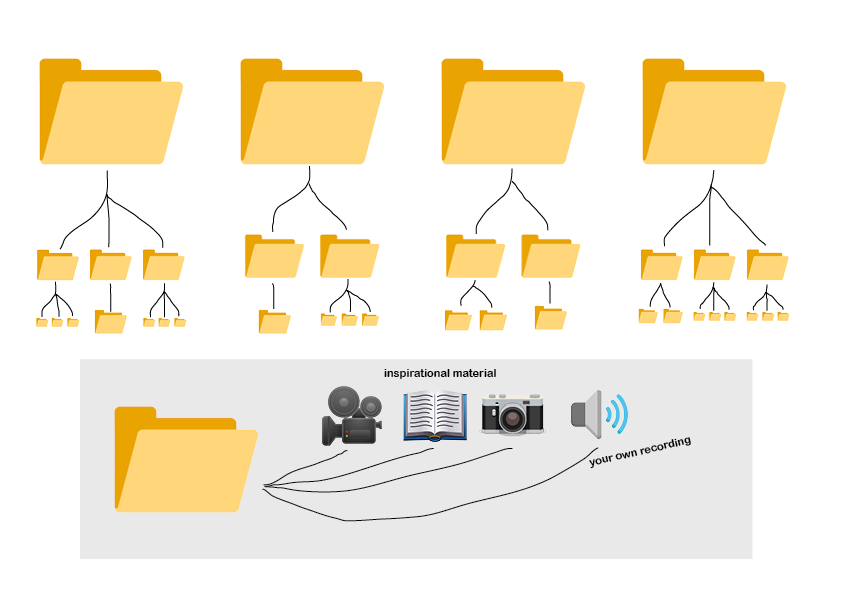
Dumping images, texts and videos: You should stop dumping images, texts and videos on the [deadline]. You can find the folders here: [soupboat link]. Do not add any more files [or...?] to the already existing files but you can add stuff to the ones we made for you. The file names of the different material you add should be the date you dumped it in the folder (e.g.: 10.06.2022). If you have several files with the same name, you can add _1, _2, etc. at the end of the file name.
Dumping the final audios: Name the audio file after the date that you recorded the audio. Drop it here: [soupboat link]. And same here: If you have several files with the same name, you can add _1, _2, etc. at the end of the file name.
Restrictions and techniques: - You are not allowed to record yourself speaking (unless you find yourself "accidentally" talking during the field recording but DO NOT STAGE/PREPARE a speech) - Techniques: [are they allowed to edit the recordings? How? What mic should they use? etc.] – time restrictions for the audio files?
– field recordings – sound memo / voice memo
PLAN FOR US
constraints for us till tomorrow: https://hub.xpub.nl/soupboat/test_SI18_SEVEN/
no sound in the folders, only text or images or videos
to do list:
-find a good title -write down proposal -add stuff in the folder
method = folder nesting topic = the relations/implicancies recording technique= field recording
method/approach = the relations/implicancies / diffractive reading structure: folder nesting topic/content/material = abstract, poetic, textures, patterns recording technique= field recordings
RESOURCES ABOUT FIELD RECORDING
https://www.sfu.ca/sonic-studio-webdav/cmns/Handbook%20Tutorial/FieldRecording.html#A https://acloserlisten.com/2019/12/30/a-closer-listens-best-field-recording-soundscape-albums-of-the-decade/ https://citiesandmemory.com/2017/10/best-field-recording-records/
Interview about field recording: https://static1.squarespace.com/static/545aad98e4b0f1f9150ad5c3/t/545adc2ee4b0028b03c47574/1415240750107/In+the+Field.pdf https://www.soundguys.com/field-recording-guide-26352/
FOLDERS
understand the folder structure as a way to navigate from a stating point (main folder) to an unknown destination. on the way you find/encounter various things that influence your perception and also the path you are choosing folders not as vertical hierarchy but as a horizontal branching map
Folder1 = [Unfolding [] Implicancies]
what content? what do you feel while you're travelling? if it's not loud, it's silence, they influence each other Maybe work with content related to senses in an abstract way? Like loud, silent, rough, soft, salty -> we don't need to say that the material is inspired by this but I'd think it's nice because it would be in a way give a starting point of feeling/experiencing the journey through the folders? Also i like these opposites (like loud and silent) because opposites always influence each other (without it being loud, it's silent).
Also: We need to display the content sources on the final interface
TITLE IDEAS
unraveling paths unfolding paths (emerge + unpack/opening up+folders) unfolding relations / relationalities / implicancies UNFOLDING IMPLICANCIES
OUR IMPRESSIONS while adding
adding files that work in different folders make you understand how many implicancies and intra-actions there are in our content; how many things are connected to multiple things at the same time, even when they are part of different contexts. Also, this reflects how limited the folder structure is because it doesn't allow us to reconnect them.
when you have a connection and you ask yourself about creating a new folder, how do you decide? it is nice that you start thinking about what kind of connections there are in between files naming = framing
CONTENT IDEAS DUMP
(Video)
https://www.extraweg.com/artworks/aging (Oliver Latta)
https://i0.wp.com/www.printmag.com/wp-content/uploads/2021/08/fdcd5a_3db030b06ec1492880973c02e7e9fd8amv2.jpg?resize=1000%2C1000&ssl=1 (Studio Rosagrau)
 (Myriam Gämperli)
(Myriam Gämperli)

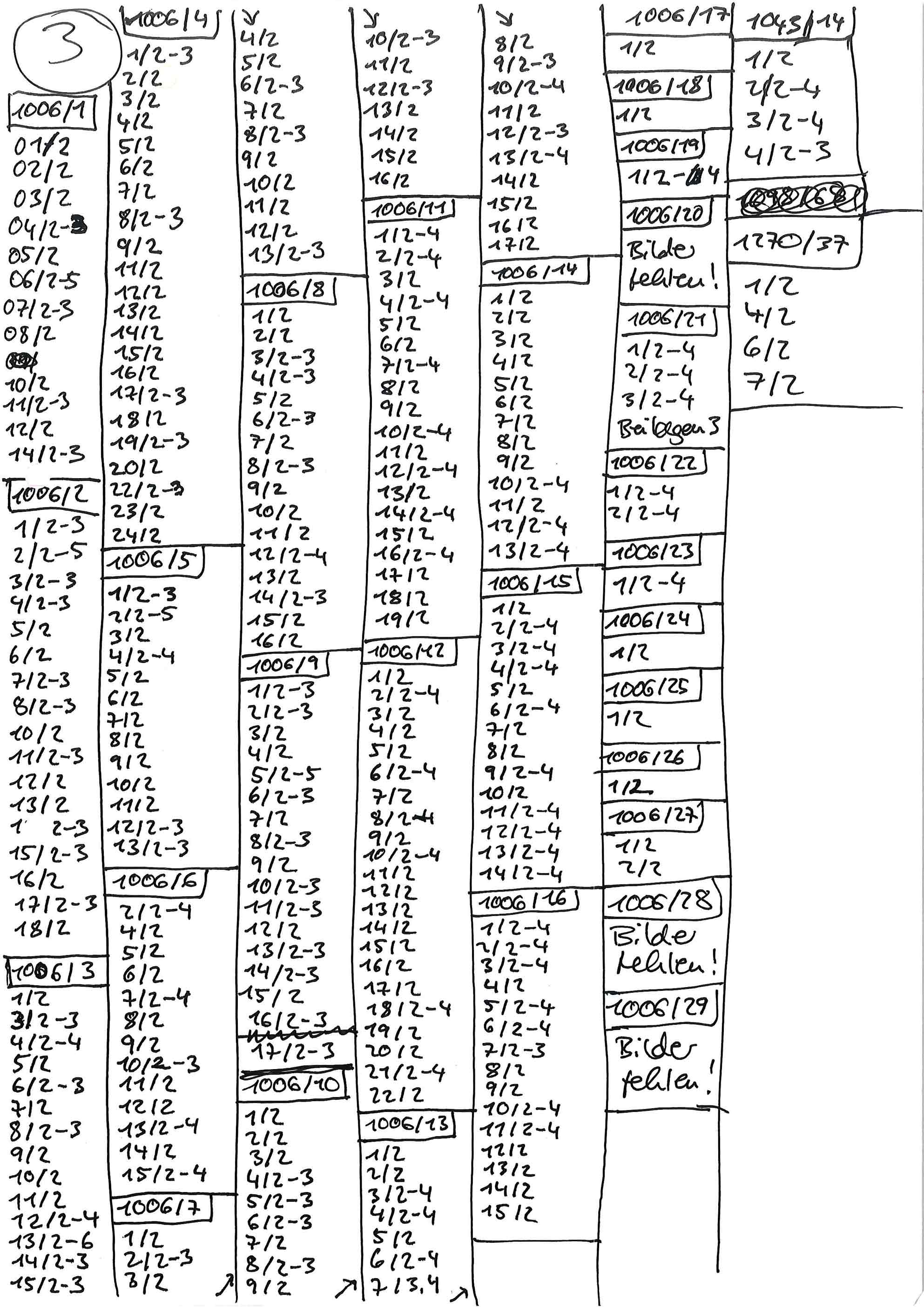

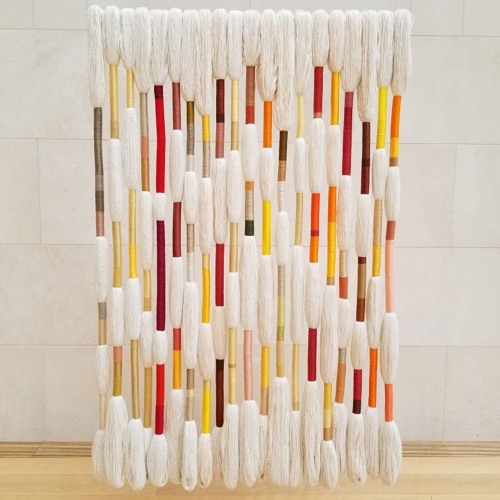 (Sheila Hicks)
(Sheila Hicks)
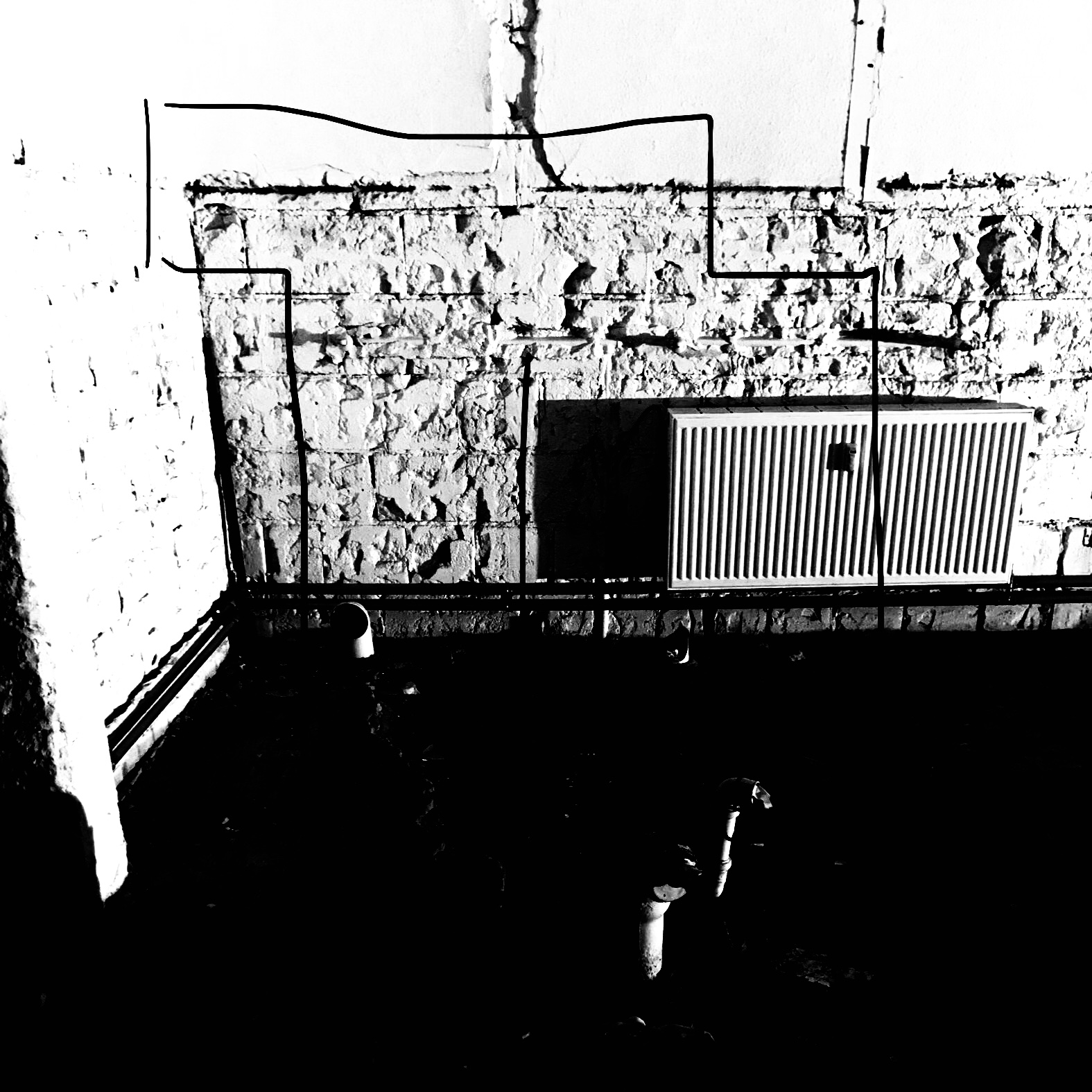
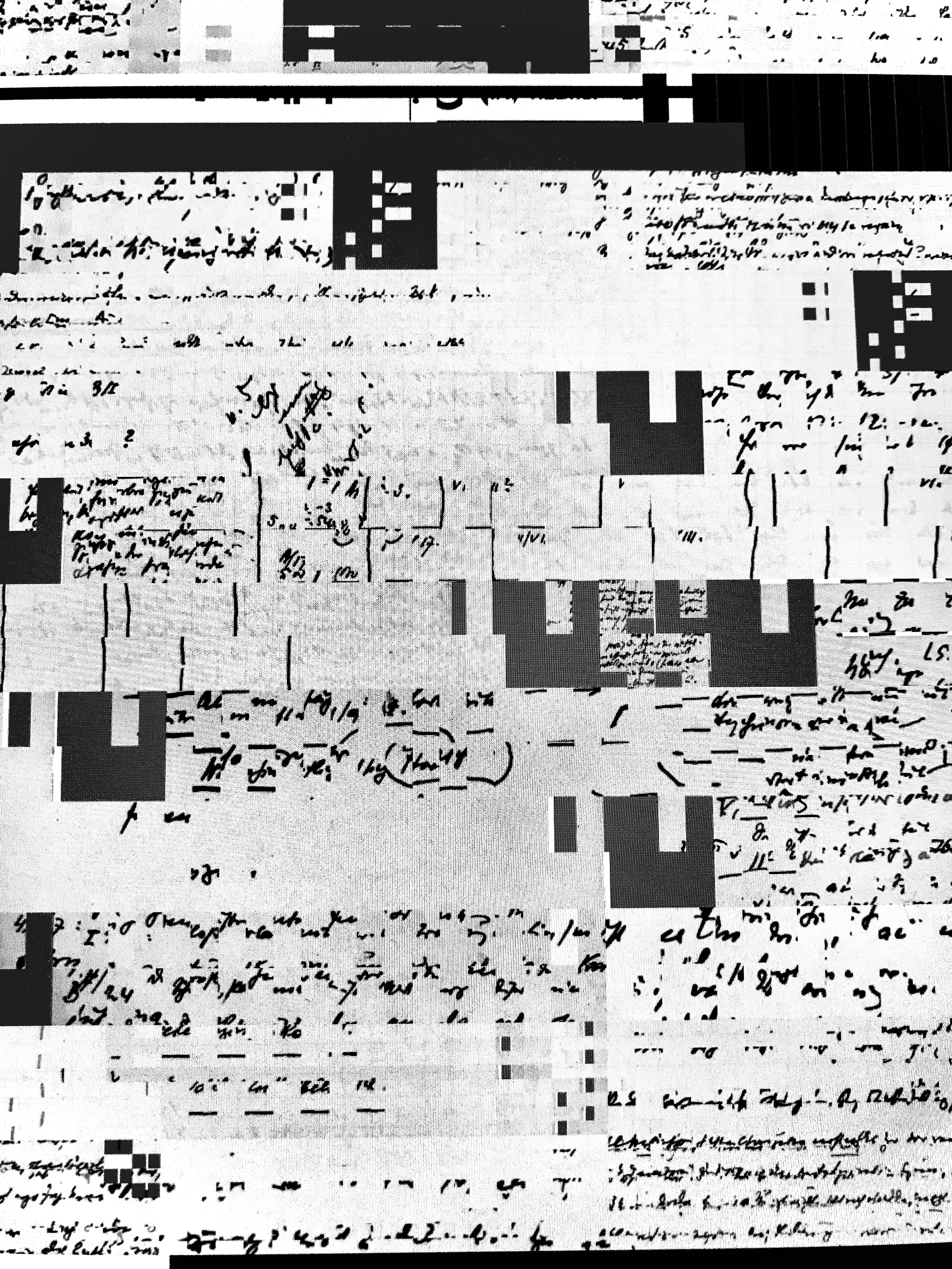

final proposal
The topic of SI18-07 is
🗂️🗂️[UNFOLDING [ ] IMPLICANCIES]🗂️🗂️
Deadlines: Starting Wednesday 7th June Deadline to upload recordings: Every evening Optional: Dumping images/texts/videos whenever it comes to you Ending by Sunday 12th June Release: 14th of June
Contributors: Mitsa Chae Kamo Erica Alex Carmen Kimberley Supi
Caretakers: Emma, Jian, Miriam
This week we will split up the groups and ask you to work on the piece on your own! It will still be a collective process because you will be actively working and communicating to each other, but through the files you upload instead of in person. [details below]
The concept This week we want to experiment with Implicancies as a method / approach. We will give you some material as a starting point and ask you to look at it in a relational / diffractive way. Starting from the material we provide on the soupboat you will work with the technique of field recording [find resources below] to produce sound recordings that can be an interpretation of that material as well as a direct reaction or annotation to it. Try to be open for the material you encounter and find inspiration in it.
The folder structure We prepared some folders on the soupboat that contain images, text excerpts and video snippets as well as subfolders containing related/implicated material again (a folder in a folder in a folder in a folder!). This little structure will be the starting point for your daily contributions and it will unfold (emerging, unpacking) through the implicancies and connections between the files you will upload day by day.
Of course the folder structure imposes a hierarchy, but we invite you to look at it as a way to navigate from a starting point (main folder) to an unknown destination. On the way you will encounter things that could influence your perception and also the path you are choosing. In that sense the folders can be looked at as a horizontal, branching map instead of a vertical hierarchy.

What do you need to do? 1. To create daily audio field recordings in conversation with the content of a folder of your choice. The audio recordings will stay just the way you upload them (they will not be merged with the other pieces) and they will be presented together with the content of the folders they are in. We want you to upload at least one audio piece every day, but you are free to go on as much as you feel like. And please don't stress out about the daily deadlines too much! A field recording could also happen while you are riding your bike or in the supermarket – as long as it is in conversation with the material you encountered in the folders.
2. Create new folders, new paths, and upload new inspirational content (text files or screenshots, images, videos etc.) in relation to what you see or listen to day by day from the already existing content. This is optional, but the more everyone uploads and unfolds the branches, the more complex and entangled the result will be.
All the content you create or upload will influence and shape the following contributions. So it is essential that you upload things day by day!
Step by step instructions [if you still don't get it] You first go to the first folder. In there you might find an image that triggers your imagination and you decide to make a field recording based on it. Then you drop the audio in this folder. In this folder you also find subfolders where you find inspiring content again. You repeat the process. If you want, you can also add more folders, images, text excerpts or videos to the folders. In this way, the material in the folders changes day by day and from the new material people get different associations again and create different content that will find its way in the folders again.
Where? [Dumping the recordings, images, texts and videos] The starter-folder is Unfolding_implicancies, you can find it on the soupboat at: shared/html/SI18/07/Unfolding_Implicancies
How to name the files: Whenever you upload a file or create a new folder, please think about how you name it! It could be the location of your field recording or a keyword that relates to your file, or something else. Just remember that the name also gives a certain context to your file and will shape the way it is perceived by the others!
The technique: field recording
The technique we ask you to use is field recording. You can rent field recording microphones in the school rental station or use your own methods/recorders. [1]
Field recording is the term used for an audio recording produced outside a recording studio, and the term applies to recordings of both natural and human-produced sounds. It also applies to sound recordings like electromagnetic fields or vibrations using different microphones like a passive magnetic antenna for electromagnetic recordings or contact microphones. For underwater field recordings, a field recordist uses hydrophones to capture the sounds and/or movements of whales, or other aquatic organisms. These recordings are very useful for sound designers. [Wikipedia]

Restrictions and guidelines Recording: You are not allowed to record yourself speaking (unless you find yourself or someone else "accidentally" talking during the field recording but DO NOT STAGE/PREPARE a speech). Editing: You are allowed to edit the recordings if you want (but keep in mind that this is still a field recording and not a composition, so you can also upload the files as they are) Tools: Preferably field recording microphones, but you can also choose different recording methods. If you want to use your phone: "We recommend downloading a sound recording app like Vice Record Pro (iOS) or Hi-res Audio Recorder (Android)." Settings advice for recording apps: File type: .WAV. Channels: Choose ‘mono’ over ‘stereo’. Automatic gain control: OFF, so that you can manually control the record level. Level setting: ensure the peak is between -6 and -12 dB. Recording quality: set to the highest possible setting or example sample rate of 48 kHz, 24 bits. Remember to keep an eye on your waveform and ensure that the incoming sound isn’t too strong or weak. [find the rest of the article below: loopcloud.com] Duration of the audio files: No restrictions but let us know beforehand if you plan on making a really long piece.
Resources _field recording [We invite you to read a bit about field recording and listen to other people's pieces; the technique offers a wide range of approaches] Guide with photos and examples: https://www.sfu.ca/sonic-studio-webdav/cmns/Handbook%20Tutorial/FieldRecording.html#A Albums: https://acloserlisten.com/2019/12/30/a-closer-listens-best-field-recording-soundscape-albums-of-the-decade/ Albums: https://citiesandmemory.com/2017/10/best-field-recording-records/ Interview: https://static1.squarespace.com/static/545aad98e4b0f1f9150ad5c3/t/545adc2ee4b0028b03c47574/1415240750107/In+the+Field.pdf https://www.soundguys.com/field-recording-guide-26352/ "Writing the Field Recording" [interesting text about relation between field recording and writing]: https://hub.xpub.nl/soupboat/~flem/books/Stephen%20Benson%20-%20Writing%20the%20Field%20Recording_%20Sound%2C%20Word%2C%20Environment%20%282018%2C%20Edinburgh%20University%20Press%29%20-%20libgen.lc.pdf Guide: https://www.loopcloud.com/cloud/blog/4471-The-Loopcloud-guide-to-field-recording About field recording and listening (cool): https://www.factmag.com/2014/11/18/a-beginners-guide-to-field-recording/
_unfolding implicancies 1. https://vandal.ist/thesituationisttimes/04/index.html#8/-2.033/119.117 2. https://www.batiasuter.org/bs073.html
Q&A
[every day at 10am]
1. When is the moment to create a new folder? If you feel like you have something that is inspired by the material in a folder but adds a new aspects or goes in a slightly different direction than the above-mentioned files, then it's the moment to create a new folder as a new starting point. Just try it and see how others react to it!
2. Who is invited to contribute to the folder structure? Within this release, as it's based on impressions and connections everyone is able to make, we thought it could be an interesting experiment to share the task with other people outside XPUB 1, also to have a bigger variety of content and points of view. Therefore, you can think about someone that could be interested and share this link to invite them to look at the already existing files and folders: https://hub.xpub.nl/soupboat/SI18/07/ If they want to contribute a file (field recording, text file, image …), ask them to send it to you so that you can upload it in the right folder on the soupboat.
3. What if I want to use work from other people? In the main folder you can find a text-file named "sources.txt" Please write down the sources and/or author of what you are using so that we can share it as a footnote in the final release! Save and close the file once your done so that others can work with it as well without conflicts!
4. What happens if I have a file that works in different folders? Great! This is an interesting moment! As we mentioned before, the folder hierarchy is maybe not the best way to structure entangled and interconnected material. So we invite you to hack the hierarchy by duplicating your file / folder and put it in both places! Let's see what happens!
5. I think is going to be really difficult to borrow 12 zoom devices from school for 6 days. Also as I tried in the url [2] you cannot borrow the machines for over than 1 day. (mitsa) True! For some of you its maybe more convenient to use their phones or others devices for recording. Under "restrictions and guidelines" you can find some tipps for good recording apps! Still, try to make use of the rentals if you can :)
